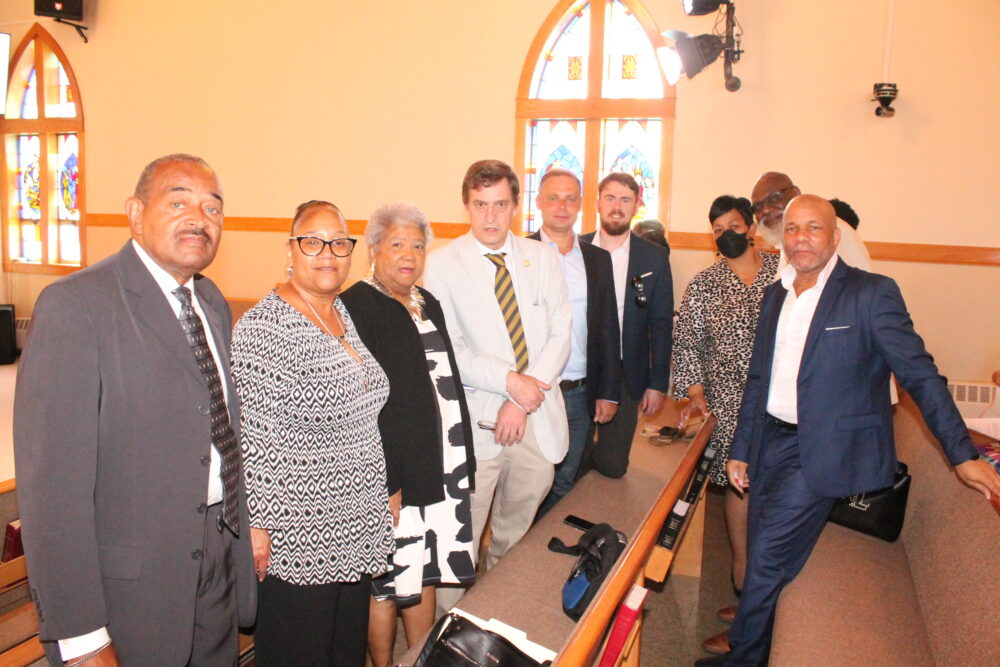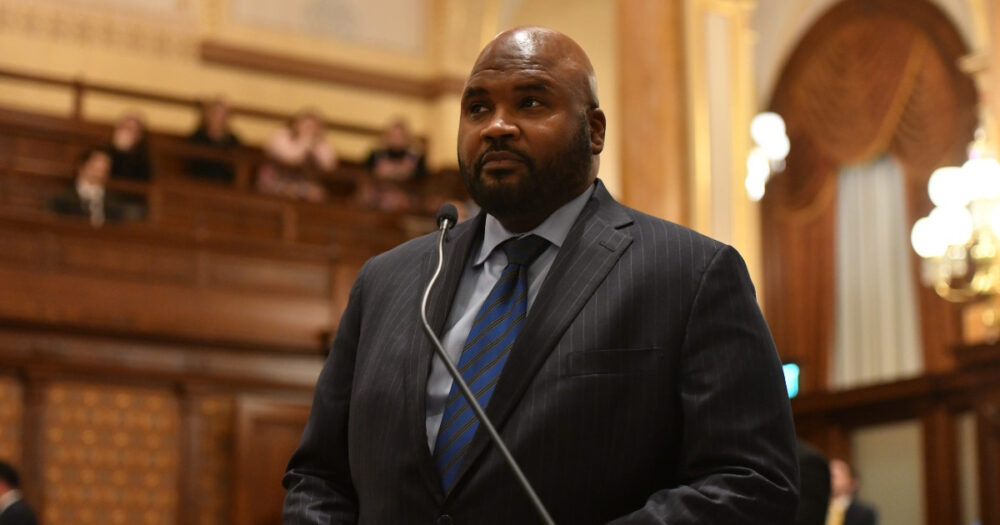Struggling to breathe, Patty Cowick knew she had to head to the emergency room at Blessing Hospital in Quincy in May.
But she dreaded the discomfort and confinement of staying in the hospital. Cowick, 60, has congestive heart failure and chronic obstructive pulmonary disease (COPD) and had been hospitalized before.
Advertisement
“I said can’t you do something and let me go home?” she said. “They came back a while later and said we have a program that might fit for you.”
They told her she could receive hospital care at home, with daily visits from nurses and virtual check-ins with a doctor. Cowick spent about three days receiving hospital care at her home in rural Kellerville, resting in her rose-colored recliner and watching traffic go by from her front porch.
Advertisement
“I can’t stand to be shut up in a room with no fresh air, like the hospital is,” Cowick said. “It’s been a long road, but I really am thankful for this program.”
Blessing is one of a handful of hospitals across the state — along with Northwestern Memorial, University of Chicago Medical Center and OSF Saint Francis Medical Center in Peoria — that have received federal permission to provide hospital care to some patients at home. It’s a program that the federal government started during the pandemic as a way to help hospitals free up space, but Illinois hospital leaders hope to see it continue long term as a way to make patients more comfortable, keep hospital beds open for others and save money.
“We don’t see it as just a small program for utilization during the COVID pandemic,” said Dr. Luke Neill, medical director of the Hospital at Home program at Northwestern. “We see this as a big shift in care.”
Northwestern treated its first hospital-at-home patient in March, and hopes to eventually serve about 300 patients a year at home. Blessing Hospital in Quincy has treated about half a dozen patients at home since February. OSF Saint Francis and University of Chicago Medical Center are still gearing up, with hopes of starting later this summer and within the next year, respectively.
It takes a lot of work to start the programs, hospital leaders say. Hospitals must abide by a strict set of rules in order to bill Medicare and Medicaid for patients treated at home, under federal waivers.
For one, only patients with certain types of conditions are eligible. Those conditions may vary by hospital, but often include cellulitis (a type of skin infection), pneumonia, urinary tract infections, congestive heart failure and chronic obstructive pulmonary disease (COPD), Neill said. They’re conditions for which the treatment is relatively straightforward, patients are unlikely to require a lot of imaging, and the risk of patients getting sicker once they start treatment is fairly low, Neill said.
To be eligible, patients also typically need to be on Medicare parts A or B, or Medicaid, unless a hospital has reached agreements with other types of insurance plans to be reimbursed for care at home, Neill said.
Patients who participate must typically be visited, in-person, twice each day by a nurse. A doctor must also check in with patients each day, either in-person or virtually. Patients must be able to immediately reach providers over audio. And hospitals must be able to supply all the equipment, medications and meals a patient may need.
Advertisement
When Cowick participated in Blessing Hospital’s program in May, she didn’t have internet access in her home, so the hospital lent her a tablet and a hot spot, allowing her to video chat with a doctor each day.
She also wore a monitor on her chest that continuously sent readings to doctors and nurses.
The monitor tracked her heart rate, oxygen and respiratory rate, said Dr. Mary Frances Barthel, chief quality and safety officer for Blessing Health System. “If there’s any kind of parameter that gets out of whack, the system will alert me on my phone,” Barthel said.
Doctors say they’re also able to learn more about patients by visiting their homes.
Northwestern doctors learned that their first hospital-at-home patient, Diana Calleros, was ingesting more sodium than she realized while visiting her home in Chicago’s Bush neighborhood. The 78-year-old woman was hospitalized in March for congestive heart failure, and about two days into her hospital stay, doctors asked if she’d like to spend the last couple of days of her hospitalization receiving care at home. She agreed, and spent the rest of her “hospital stay” at home, sleeping in her own bed, her feet propped up on a pillow.
While at her home, Neill asked Calleros if she added a lot of salt to her food. She said no.
Advertisement
But then Calleros’ daughter brought out her jar of Knorr chicken bouillon for the doctor to see. It’s a common ingredient in Mexican American cooking, and something Calleros used every day, she said.
“He looked at it and said, ‘Oh no,’ ” Calleros said of Neill. It was packed with sodium. Too much sodium can make the body retain fluid, which can be especially problematic for people prone to congestive heart failure. Congestive heart failure is when the heart doesn’t pump blood as well as it should, which can cause fluid buildup in the lungs and other parts of the body.
“If she were inside the hospital, I probably would have never understood the type of sodium she actually had in her diet and been able to counsel her on what I think would be the appropriate use of sodium,” Neill said.
Hospital leaders say the program can also help save money.
A 2019 study out of Brigham and Women’s Hospital in Boston found that hospitalizing patients at home cost an average of 38% less than caring for patients in the hospital.
Patients hospitalized at home had less imaging, fewer lab tests and fewer consultations with other providers, according to the study, which was published in the peer-reviewed journal the Annals of Internal Medicine. They were also readmitted less frequently to the hospital within 30 days. The study’s authors said they might have been less likely to be readmitted because, at home, they were sleeping better and moving around more than they would have in the hospital.
Advertisement
“Unfortunately, although we like to think the inside of the hospital is a safe place, there’s also a lot of challenges that can exist, from hospital-acquired infections to falls because people aren’t as comfortable with the environment,” Neill said.
That’s part of the reason Neill and others would like to see the federal government allow the program to continue long term. Now, the program is set to expire at the end of the federal COVID-19 Public Health Emergency in mid-July.
There’s a bill before Congress that would extend the hospital-at-home program for two years beyond the public health emergency. That bill, however, is still awaiting a committee hearing, meaning it has a long way to go before potentially becoming law.
Or, the administration of President Joe Biden could extend the public health emergency beyond July, which would keep the program going longer. The administration has not yet publicly announced an extension of the emergency, but it has said it would give 60 days notice before ending it, and it has not yet given that notice.
Despite the uncertainty, local hospital leaders are optimistic that this is the beginning, rather than the end, of hospital care at home.
OSF HealthCare started admitting patients for hospital care at home in 2020, partly as a way to help keep beds available during COVID-19 surges. Because the federal program hadn’t yet started at that point, the hospital didn’t always have a way to bill for that care, said Jennifer Junis, senior vice president for OSF OnCall Digital Health.
Advertisement
When the federal program started, OSF applied to be part of it, and paused its at-home admissions as it worked to adjust to the federal program’s requirements. OSF leaders are eager to once again get started.
“We have capacity issues at our flagship hospital in Peoria at Saint Francis even when we don’t have COVID,” Junis said. “Anything we can do to offload some of that capacity is really important. We think this is a new care delivery model that’s not going away. … This is creating a better patient experience.”







